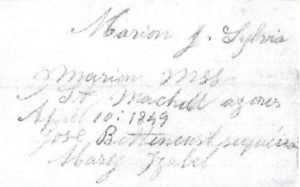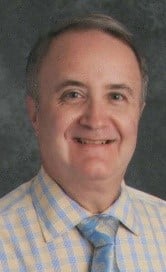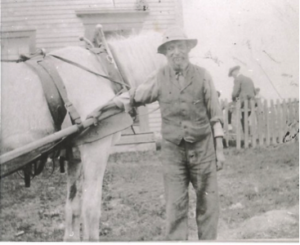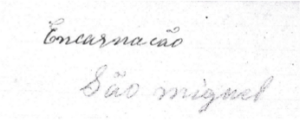In 1982, when I discovered my mother’s great-grandfather, Azorean immigrant Marion Sylvia (ca. 1847–1924), Mom asked me, “How much Portuguese ancestry do I have?” Marion remains my only identified maternal forebear without any links to the British Isles. Long before DNA analysis, I calculated Mom’s Portuguese ethnicity at 12.5%, with her mother at 25%, and her maternal grandmother, Marion’s daughter, at 50%. Now, we all know these percentages may not match the amount of atDNA after four or five generations.
Leaving that aside for a moment, let us consider the unsolved mystery of Marion Sylvia. Born on the island of Sao Miguel [St. Michael], Azores in the mid-to-late 1840s, Marion told his grandson Walter Rhodes that he was a teenage stowaway aboard a whaling vessel that brought him to Massachusetts. What circumstances prompted a young man to leave home so surreptitiously? Is the information Marion later recorded on a scrap of paper correct concerning his birthplace and parentage?
 Front: Marion J. Sylvia/Marion Mss/ St.Machell Azores/April 10 1849/Jose Bettencurtsequeira/Mary Izabel.
Front: Marion J. Sylvia/Marion Mss/ St.Machell Azores/April 10 1849/Jose Bettencurtsequeira/Mary Izabel.
Out of my depth with Portuguese research, I enlisted the help of several genealogists who specialized in the Azores. First hurdle: over 75 Catholic parishes [freguesias] in Sao Miguel! Where was Marion baptized, assuming he was baptized? Was Jose Bettencourtsequeira the name of Marion’s father? Encarnacao: a surname or the name of a parish? Various Bettencourt genealogies recount that in the 15th century a Flemish nobleman of that name was given a land grant on the island of Terceira. Other families claim descent from Sephardic Jews exiled from Spain. Diligent research among baptismal records failed to identify any match to a child likely named Mariano born during this timeframe to anyone of the various surnames mentioned. I have long assumed Marion’s real name was Mariano; however, given his long association with the town where he settled, I wonder if he adopted Marion as his own name.
On this side of the Atlantic, scant clues illumined how and when Marion arrived in New England.[1] Most whaling vessels in the 1860s stopped at Horta in Faial, not Ponta Delgada on Sao Miguel. Oddly enough, the first piece of documentary evidence I found places him aboard the outgoing schooner Graduate departing Marion, Massachusetts on 18 May 1869. This manifest describes Marion Silva, 20, as 5’ 3” with dark skin and eyes.[2] Four months into its voyage, the vessel broke in two during a hurricane. First officer William Henry Harrison Ryder left a harrowing account, widely circulated in newspapers, of the disaster and rescue, listing Mariano [sic] Silva among the surviving crew. Their homeward trek must have been circuitous because they elude the 1870 census.
By the summer of 1879, Marion lived in Fairhaven, Massachusetts, where he wed divorced Block Island native Mary Bethiah Paine.[3] Their marriage record omits the name of his father, listing his mother only as “Mary J. Silva.”[4] Unusual among the growing community of Azorean immigrants in greater New Bedford, Marion seemed to lack ties to anyone else born in the Azores. In the spring of 1880, the Sylvias bought the former Jonathan Dexter homestead in Marion, Massachusetts. Their four children were baptized as Episcopalians. Marion, “tough as a pine nut” in the words of a grandchild, farmed there until his death in 1924. An obituary in The New Bedford Standard Times alleged he was brought to Massachusetts by his parents when a small child. No mention of any siblings.
Marion, “tough as a pine nut” in the words of a grandchild, farmed [in Marion] until his death in 1924.
Consequently, with a dead-end paper trail, I hoped my mother’s DNA test results would lead me to a string of connected families from the Azores. Not so fast! Of course, I anticipated seeing only a small amount of DNA from the Iberian peninsula, but I was confounded by the varying estimates among companies:
- Ancestry.com predicted Mom had 1% Portugal in 2018. Updates in 2019 and 2020 dropped Portugal entirely and changed to 2% Spain, where it now stands.
- 23andme.com predicted Mom had 3.8 % Portugal. That changed to 12.9% in 2020, full circle to the prediction I made at beginning of this quest!
- myheritage.com calculated 96.8% from northern and western Europe, with 1.2 % Ashkenazi Jewish.
- Living DNA claims 7% from the Iberian Peninsula.
My experience has taught me not to rely upon ethnicity estimates from a single company!
With the cooperation of great-great-grandfather Marion Sylvia’s other descendants who have shared their DNA results with me, this research tactic has already brought more families from the Azores into our orbit. That’s part of the excitement of genetic research—tomorrow or next week, I may get the “You have a new match notice.” As more people test, it brings me closer to the possibility that some distant cousin’s genetic code may hold the key to identifying Marion/Mariano Sylvia’s ancestors.
Notes
[1] Marion J. Sylvia’s naturalization record, from 28 February 1890, claims he emigrated from St. Michaels on 8 September 1867.
[2] Whaling Crew List Database at whalingmuseum.org
[3] For more on Mary Paine’s first marriage, see Michael Dwyer, “A Case of Civil War PTSD,” 22 February 2018.
[4] Massachusetts Vital Records, 1841–1910, 307: 87.
Share this:

About Michael Dwyer
Michael F. Dwyer first joined NEHGS on a student membership. A Fellow of the American Society of Genealogists, he writes a bimonthly column on Lost Names in Vermont—French Canadian names that have been changed. His articles have been published in the Register, American Ancestors, The American Genealogist, The Maine Genealogist, and Rhode Island Roots, among others. The Vermont Department of Education's 2004 Teacher of the Year, Michael retired in June 2018 after 35 years of teaching subjects he loves—English and history.View all posts by Michael Dwyer →

